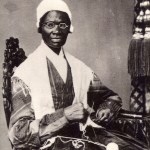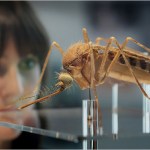education
tags: Brown Noddy, Common Noddy, Anous stolidus, birds, mystery bird, bird ID quiz
[Mystery bird] Brown Noddy, also known as the Common Noddy, Anous stolidus, photographed on Midway Atoll National Wildlife Refuge, Midway Island, Hawai'i. [I will identify this bird for you in 48 hours]
Image: Joe Fuhrman, March 2010. I encourage you to purchase images from this professional photographer.
NOTE: PLEASE name at least one field mark that supports your identification.
Review all mystery birds to date.
Around 470 people voted in yesterday's optics quiz. I continue to be amazed at the power of radio button polls to bring people into the blog.
As of early Friday morning, the correct answer is solidly in he lead-- 63% of respondants have correctly replied that the image remains intact, but is half as bright. You can see this fairly easily by looking at a traditional ray diagram of the image-forming process (re-drawn slightly from yesterday's picture, to get the arrows right):
The arrows in this picture show the paths followed by three different rays of light that all leave from the tip of the…
tags: Hooked by an Octopus, animals, zoology, invertebrates, octopus, marine biology, film maker, animal behavior, Mike deGruy, TEDTalks, streaming video
Underwater filmmaker Mike deGruy has spent decades looking intimately at the ocean. A consummate storyteller, he takes the stage at Mission Blue to share his awe and excitement -- and his fears -- about the blue heart of our planet.
TEDTalks is a daily video podcast of the best talks and performances from the TED Conference, where the world's leading thinkers and doers give the talk of their lives in 18 minutes. Featured speakers have…
A month or so ago I posted on Scholarly Societies: Why Bother?, basically on the challenges that scholarly societies face in the digital age. I got a few good comments, getting a nice discussion going.
I also posed a few questions directly to scholarly societies but unfortunately didn't get any comments from any of the various societies themselves. I did find that a bit disappointing in that the public conversation seemed to be happening without them. Never a good thing in the digital age.
Today, however, Kevin Marvel of the American Astronomical Society added a comment to my original…
I'm the lone female in a house of men - when new housemate Phil moves in next month that will make six guys in my home and well, me. There are assorted female creatures on my farm - to be precise, one dog, two cats, two rabbits, 7 dairy goats, 12 ewes (seasonal) and about 40 female birds of various types, but they do not count.
Because I'm the only female in the household, I cannot but be aware that some of the messages they get about male and female roles will be built in a fairly narrow body of evidence - ie, the woman they see most is me, so how we do things may look like…
I was starting to type up the next Laser Smackdown entry, when it occurred to me that this was a good point to talk about a neat little thing from optics. It further occurred to me that this would be a good poll/quiz topic, to see what people think before I give you the real answer.
So, here's the scenario: You have a brightly illuminated object, the canonical example being a vertical arrow (it could also be a shadow cast in a beam of light). You take a lens, and put it in front of the arrow, projecting an image of the arrow on a screen, like so:
As you can see from the picture, the image…
tags: Egyptian Goose, Alopochen aegyptiacus, birds, mystery bird, bird ID quiz
[Mystery bird] Egyptian Goose, Alopochen aegyptiacus, photographed at the Main River, Frankfurt am Main, Germany. [I will identify this bird for you in 48 hours]
Image: GrrlScientist, 14 April 2010 [larger view].
Please name at least one field mark that supports your identification.
here's another look at this species, to give you an idea of the region of the bird that I was photographing (the wing, mostly).
Review all mystery birds to date.
(Source)
But which one should be diagnosed?
Diagnostic criteria for 313.81 Oppositional Defiant Disorder
A. A pattern of negativistic, hostile, and defiant behavior lasting at least 6 months, during which four (or more) of the following are present:
(1) often loses temper
(2) often argues with adults
(3) often actively defies or refuses to comply with adults' requests or rules
(4) often deliberately annoys people
(5) often blames others for his or her mistakes or misbehavior
(6) is often touchy or easily annoyed by others
(7) is often angry and resentful
(…
Today is show and tell. I would like to show and tell you about two of my favorite textbooks for physics. Yes, I know. I have talked about these before, but you can't stop me. Both of these are alpha-super-awesome.
Matter and Interactions
This is a Calculus-based introductory physics textbook (from Wiley). The intended audience are engineers and scientists - in particular physics majors and chemistry majors. Computer science majors would do well to use this book also. So, why do I like this? Here are some of my favorite features.
"Modern" and fundamental approach. If you look at…
"Mr. Tangarone, a 17-year veteran of the Weston school system, claims that a program he wanted to teach about Charles Darwin and Abraham Lincoln was rejected by the school administration because it involved teaching evolution -- the scientific theory that all life is related and has descended from a common ancestor."
Mark Tangarone, who teaches third, fourth, and fifth grade students in the Talented and Gifted (TAG) program at Weston Intermediate School, said he is retiring at the end of the current school year because of a clash with the school administration over the teaching of evolution…
What's the application? Telecommunications, namely, the sending of messages over very long distances by encoding them in light pulses which are sent over optical fibers.
What problem(s) is it the solution to? "How can we send large numbers of messages from one place to another more efficiently than with electrical pulses sent down copper wires?"
How does it work? The concept is dead simple: You take a signal and encode it in light-- this could be analog, like the SpectraSound demo LaserFest is selling, with higher intensity meaning higher signal, or it could be digital, with a bright pulse…
tags: Great Argus Pheasant, Argusianus argus, birds, mystery bird, bird ID quiz
[Mystery bird] Great Argus Pheasant, Argusianus argus, photographed in the Senkenberg Museum, Frankfurt am Main, Germany. [I will identify this bird for you in 48 hours]
Image: GrrlScientist, 13 April 2010 [larger view].
Please name at least one field mark that supports your identification.
Review all mystery birds to date.
I am currently on a committee looking to set some standards for technical writing in the introductory engineering sequence (which means the first two terms of physics, as they constitute 50-67% of the classes common to all first-year engineers). One of our jobs is to come up with a list of skills that we want to particularly emphasize in student writing in the first year.
I've already sent this query to my colleagues, who are the votes that really matter, but this seems like a worthy subject for a blog poll. If nothing else, it will be interesting to see if my wise and worldly readers prefer…
I don't know.
One the one hand, it would seem that teachers (and really I am talking about grade school level and maybe middle school) need to be good an managing students. What should a teacher have to help students? I think the first big question is "what is going to happen in the classroom?" Let me take two extremes:
Lecture-traditional. Basically just your normal lecture.
Something else - for example stuff that high school physics/math/computer science teacher Shawn does.
Although I really don't know the answer, I am going to lean towards - teachers need some content expertise.…
tags: Dusky Kinglet, Ruby-crown, Ruby-crowned Kinglet, Regulus calendula, birds, mystery bird, bird ID quiz
[Mystery bird] Ruby-crowned Kinglet, also known as the Dusky Kinglet or as the Ruby-Crown, Regulus calendula, photographed on the Brazos Bend State Park, Needville, Texas. [I will identify this bird for you in 48 hours]
Image: Joseph Kennedy, 10 January 2010 [larger view].
Nikon D200, Kowa 883 telescope with TSN-PZ camera eyepiece 1/180s f/8.0 at 1000.0mm iso400.
Please name at least one field mark that supports your identification.
Review all mystery birds to date.
tags: PiXar, NeXt, Apple computers, technology, follow your passion, education, advice, Stanford University, Steve Jobs, streaming video
Steve Jobs demonstrates tremendous tunnel vision as he talks about his life in his 2005 commencement speech at Stanford University. Unfortunately for the rest of the world, this white man with a loving family makes a huge and very basic error in logic: because he somehow managed to "make it" doesn't mean that everyone does -- or will. Most of us fail, and fail miserably, and fail publicly, and we fail repeatedly until the day we die as we strive to do what…
Something I ran across by accident, while perusing our latest copy of Issues in Science and Technology: currently, the National Academies are sponsoring a Visual Culture and Evolution Online Symposium. It runs through Wednesday. What that means, apparently, is their panelists discuss the intersection of design, art, and culture with evolutionary biology concepts (sexual selection, genetics, adaptation, etc.) at a blog set up for the purpose.
The blog is basic (generic template), and a bit confusing. What seems to be happening is that panelists' ongoing contributions are folded into the posts…
Photo: Peter Macdiarmid/Getty Images
There's a great article at the NYT on the Cocoon, a collection of natural specimens in London's Natural History Museum's Darwin Center. Check out the slideshow to appreciate the juxtaposition of Romanesque architecture with the space-age, egg-shaped exhibition space. Very quirky.
Skeptvet has created a pithy, albeit cynical, table summarizing what scientists write, what it really means, and what the public thinks it means. I've clipped a little bit of it here, but go to Skeptvet for the whole thing. Nice work!
tags: African Skimmer, Rynchops flavirostris, birds, mystery bird, bird ID quiz
[Mystery birds] African Skimmer, Rynchops flavirostris, photographed mystery location Nyamba ya Mungo, Tanzania, Africa. [I will identify these birds for you in 48 hours]
Image: Dan Logen, 14 January 2010 [larger view].
Nikon D300, 600 x 1.4 lens ISO 320, 1/1000 sec, f/6.3. Exp comp +.3
Please name at least one field mark that supports your identification.
Review all mystery birds to date.



